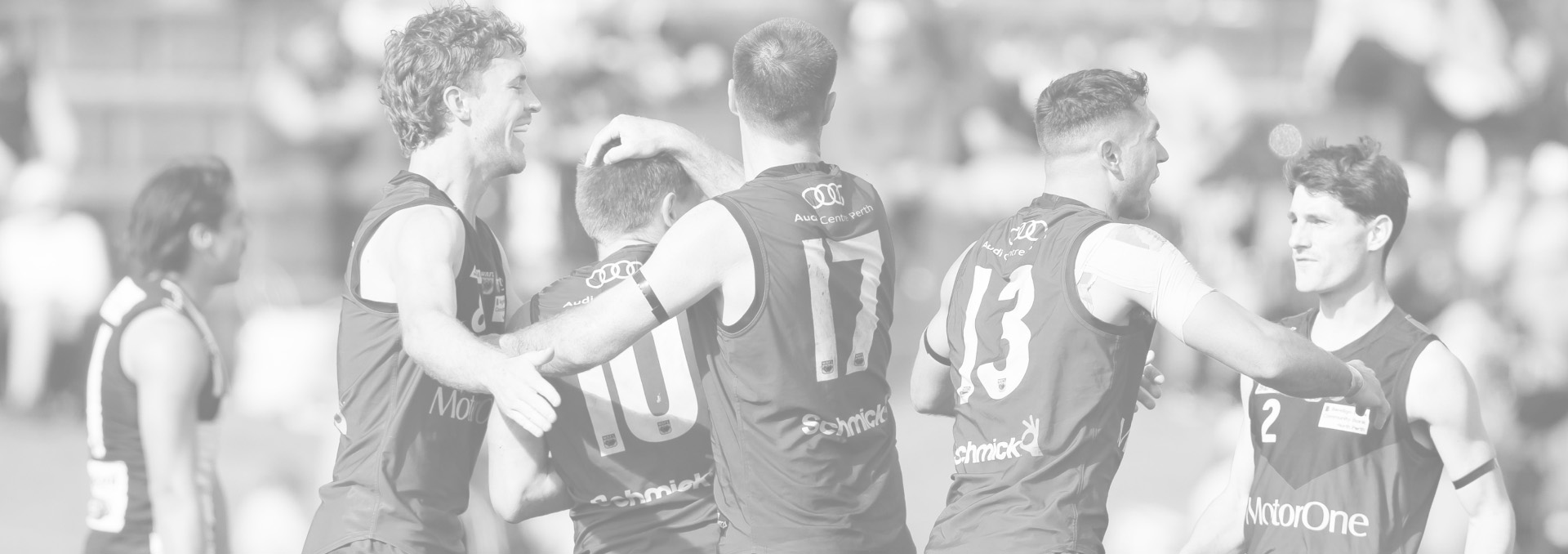
Sandover Medallists
Fourteen of the 78 Medal winners profiled in the magnificent 470-page hard-cover book were wearing the royal blue-and-black colours of East Perth in their triumphant season.
Written and produced by football journalist (and East Perth Life Member) Alan East, the book offers an amazing insight to the thoughts, feelings and achievements of the game’s stars.
The Sandover Medal Men is available at the East Perth club office for $52 a copy.
Alan Quartermaine
Fact File
Born: November 23, 1951, at Katanning, WA
Games played: East Perth 108; WA 3
Guernsey No.: 14
Position: Half-forward/centre
Won Medal at age: 23
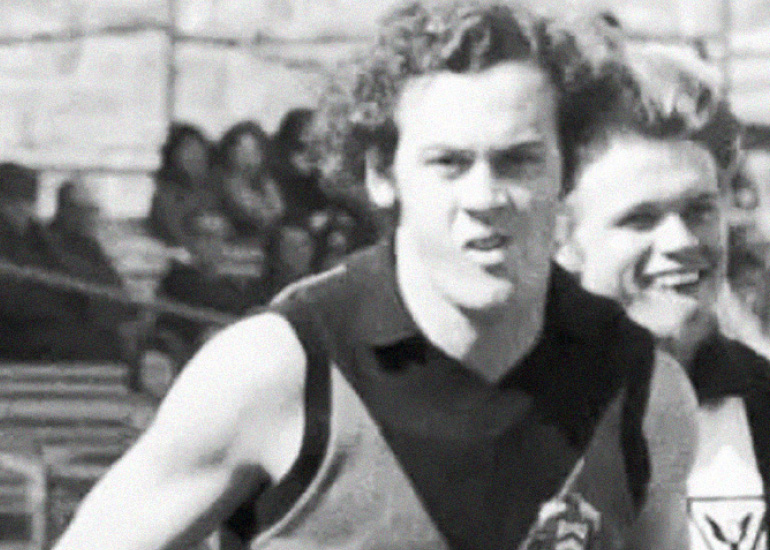

Footy wasn’t always the main focus
IT’S obviously been a pretty interesting season when three players from the same team occupy three of the top four places in a Sandover Medal count.
There are just two cases of this happening in the WA Football League and the first was 1975 when Alan Quartermaine topped the poll with 16 votes, two clear of Peter Spencer and Ross Glendinning, with Stan Nowotny (Swan Districts) also receiving 14 votes. (The second time was in 2002 when fledgling WAFL club Peel Thunder had Allistair Pickett (33); Daniel Wells (27) and Darren Bolton (23) in the top four, with Ryan Turnbull (EP) also on 27).
But while Spencer claimed most of the 1975 media awards, the winner was the 15/1 outsider … and even Quartermaine failed to take note of some last-minute happenings that would have given him an indication of the result.
Certainly former football journalist Bob Cribb, who was doing some marketing work for East Perth in 1975, admits to being a little slow on the uptake when he was dispatched to organise a dinner suit for Quartermaine and make sure he was at the Channel 7 studios in Tuart Hill for the Monday night count.
Quartermaine was a last-minute inclusion in the Royals group for the function, but he recalls the late invitation being extended the day before the count.
“Certainly I wasn’t thinking about going to the presentation until I got the last-minute call,” recalls Quartermaine. “But the penny didn’t drop even when I got there. I had played some good games, but Peter Spencer, Ross Glendinning and myself would always share the best-player honours.
“I remember sitting with coach Ray Giblett, Peter and Ross and club President Hec Strempel. I polled in six games, but got four 3s, while Peter got votes in seven games and Ross in eight, but they were 2s and 1s.
“The games when I didn’t get a three, the other two would split the top votes. We just robbed each other all year, but I didn’t get a one vote.
“It basically came down to the last card when we played East Fremantle. Doug Green (East Fremantle captain) tells the story of how I got towelled up by David Hollins in the centre in the first half and was shifted to a half-forward flank. I really cut up and everything went right in the second half and I got the votes.
“Poor old Peter got switched into the middle, where Hollins was hot.”
Quartermaine had come up through the junior ranks at Katanning, in the southern Wheatbelt, where his father Ross was a more-than-handy footballer, winning the Caris Medal for the fairest and best player in a country carnival at 19.
Quartermaine started in juniors aged about six and was in the Katanning Wanderers Great Southern League side at 15.
His coach was famed East Fremantle and State defender Con Regan, who later described Quartermaine as the best 17-year-old he had seen, while champion rover Barry Cable told him in 1978, when coaching East Perth, that he was the most talented player he had coached, “but also the slackest.”
“I didn’t have any affiliation with WAFL clubs; I didn’t really support anyone,” he says. “There was no television, but I suppose I supported East Perth if anyone mainly because Hec Strempel had been after me for a few years. Then Kevin Murray (Royals coach) came down and presented me with his jumper and I signed with them.”
Quartermaine’s focus on moving to the city in 1969 was for study, not football, but in his first year he played four games for the Royals.
“It usually came down to the pre-season; if I did one, I was serious about playing that year, but it wasn’t whole thing,” he said.
With his economics studies at the University of WA taking up his attention, Quartermaine played two years of amateurs, 1970 and ’71, earning All Australian honours both seasons and playing in two grand finals, winning one and losing the other, with former East Perth player and later WA Football Commission chairman Peter Tannock as coach.
“East Perth did keep tabs on me in those two years, but they didn’t push me to return,” he says. “I was always going back to the club when my studies finished and I returned in 1972.”
However, while that proved to be a Royals premiership year under Mal Brown, Quartermaine wasn’t there on grand final day.
“I missed the grand final through suspension,” he laments. “I got three weeks for undue rough play on Tractor (Wayne) Reynolds. It was a joke. The goal umpire reported me from 100 metres away. John Fuhrmann was the central umpire and he just shook his head and stood up at the Tribunal and said it was only a free kick.
“It was my first report and it came in the second semi-final and cost me the grand final and I couldn’t play in Adelaide in the club carnival where Brownie had the famous fight.
“Even The West wrote an article saying the suspension was a bit harsh”
Quartermaine earned selection in the 1974 State side, leading to invitations from VFL clubs Geelong, Richmond and North Melbourne.
“But I had growing business interests in Perth and with my wife finishing a Masters degree that wasn’t available in Melbourne, I decided to stay here,” says Quartermaine. “The money in the WAFL was good then and Victoria didn’t offer much more.”
The 1975 season curtain came down with Quartermaine troubled by a groin ailment that has stopped many players.
“I played with osteo pubitis for my last four years and they didn’t have operations to fix it then,” he says. “Footy wasn’t my main driver, as I was already in business, but I was a yard slower, where my speed had been a factor in those early years.”
Quartermaine took the 1978 season off as he returned to University to do an honours degree in economics and didn’t play any footy – missing out on a premiership year at East Perth.
He returned to the Royals in 1979, but only played two games before retiring with his injury … but he wasn’t out of football for long, being appointed General Manager of the struggling Subiaco Football Club.
After two years Subiaco, Quartermaine went back into the financial world, having previously been with Custom Credit, but now as a broker, dealing mainly in heavy equipment. He is currently a director of a group of companies that includes a finance broking arm, a mortgage broking company and an insurance funding firm.
Quartermaine’s first wife Ann passed away leaving a daughter, Jessica and he has two children, Joel and Ellie, with his second wife, Erica, since divorced.
Ryan Turnbull
Fact File
Born: September 23, 1971, at Mt Lawley, WA
Games played: Claremont 23, East Perth 155, West Coast 129, WA 6
Guernsey No. 50
Position: Ruck
Age when won Medal: 29
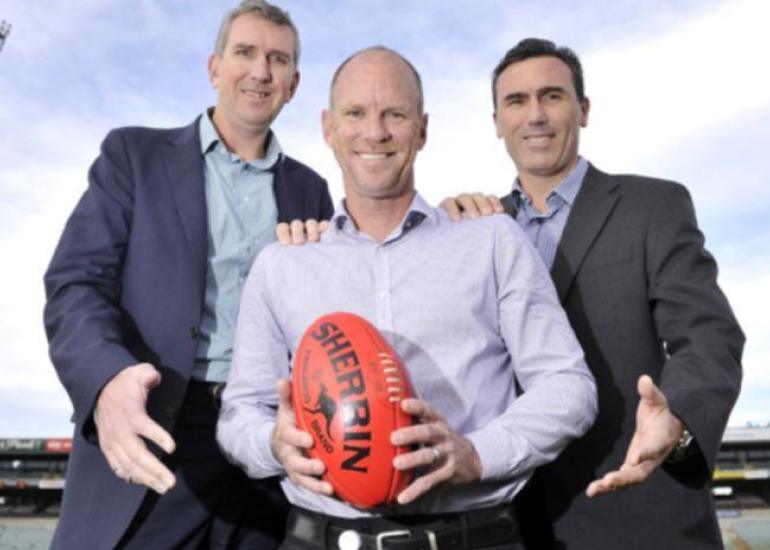

Lessons learnt at Medal counts
THERE is one thing that being a beaten favourite at a Sandover Medal count teaches you – simply don’t expect too much in subsequent seasons.
Such is the case with Ryan Turnbull, the 2001 Sandover Medallist who had twice endured the pain of going to a Medal count as favourite, only to be disappointed, although he was a one-vote runner-up in 1999 to Perth ruckman Gus Seebeck.
Turnbull’s 2001 win made history as he was the first East Perth player to claim a Sandover Medal, a grand final Simpson Medal and a premiership medallion in the same season – and that eclipsed some bygone champions such as Graham Farmer and Ted Kilmurray in the club’s 1950s Golden Era.
There were plenty of other firsts for Turnbull, who finished with 313 games at three clubs … and premierships at them all.
A teenage debutant and premiership player with Claremont in 1989, he was in the 1994 West Coast premiership side and then, when he thought he was “past it”, he added two more flags with the Royals.
But back to his Sandover Medal triumph.
“I went to the 2001 dinner not thinking I was a contender,” recalls Turnbull. “I made that mistake at previous Sandover counts when I was rated a chance to win. I was favourite in 1993 when Robbie West won (finished seventh) and again in ’99 when Gus Seebeck took it out. But at least I was only just beaten. It’s hard not to get influenced about being a favourite. You get phone calls from media people saying you’re going to win and you build your hopes up.
“But in 2001, I had a lot more happening – we had the grand final coming up and I was more focused on team goals than individual rewards. Therefore, it was a shock because I really didn’t think I was a chance. We’d had a good year with a top spread of players and I thought we’d all be taking votes off each other. And when I didn’t poll a vote in the last round I thought I’d get rolled. But I held on.”
Turnbull certainly dispelled any doubts about taking Sandover Medal celebrations into the grand final, winning the Simpson Medal for best-afield, keeping a ‘lid on things’ as he put the Sandover victory into perspective.
When you examine the football pedigree of Turnbull, it’s no surprise he became a much-decorated player – the only moot point maybe is that it wasn’t for Swan Districts, the club where father John played 209 games, including that historic hat-trick of premierships in 1961-62-63.
Add the fact that mother Kaye was a daughter of Ted Holdsworth, a great goal-kicker for Swans and it’s easy to see why Turnbull was a consistent player at two levels over 13 years.
Turnbull was tempted to take advantage of the father-son rule and play at Bassendean, despite living in Karrinyup. But he had played football at Christ Church Grammar School and with the Karrinyup Junior Football Club – often playing Alcock Cup and club football on the one weekend – and opted to follow his mates to Claremont.
While the tall Turnbull didn’t represent WA at State Schoolboys or Teal Cup level, he did have a meteoric rise once he joined Claremont in 1989. Plucked out of a University of WA team mid-season, he played a handful of colts games before being promoted for a couple of reserves matches and finishing the season in league ranks, playing in a premiership side under Gerard Neesham.
“I turned 18 on the day of the WAFL grand final and there I was playing against Sandover Medallist Craig Edwards,” recalls Turnbull. “We won by 81 points or whatever, so it was hard not to be satisfied with my first year.”
That debut earned him an Eagles call-up in the 1989 AFL draft, only to fluctuate between the two levels. A difference of opinion between Neesham and West Coast coach Mick Malthouse about where Turnbull should be used at WAFL level led to his transfer to East Perth in a bid to boost his AFL chances and that resulted in 1994 AFL grand final glory.
“While I regard the Eagles premiership as the pinnacle of my career, I certainly treasure the Claremont flag and two at East Perth,” says Turnbull, who has enjoyed tremendous support from his family, especially his father.
“He didn’t pressure me to go to Swans, far from it,” says Turnbull. “He was probably glad that I didn’t; if I had gone to Swans there would have been that constant comparison.”
Ironically, it was only his last two seasons that he was officially a Royal, having been “on loan” from Claremont via the Eagles. When he was de-listed at the end of 2001, he reverted back to being a Tiger and had to apply for a clearance to East Perth – even though he had already played 100-plus games.
“I did speak to Claremont out of respect,” he says. “I met with coach Mark Riley and there was a slight temptation to go back. But I had some strong bonds at East Perth, especially with Tony Micale. And I know the way the boys play against guys who leave the club – they would have belted me from pillar to post! It was easier to play with them than against them.”
There were several times during his loan period to East Perth when Malthouse wanted Turnbull to return to Claremont, especially when the Tigers were aligned to the Eagles. Malthouse’s rationale was that Turnbull would be under the Eagles eye a lot more.
While Turnbull was in the East Perth camp in 2000 when they broke a 22-year premiership drought, he was a fairly regular Eagle and not eligible for the grand final.
An emerging young ruckman in Dean Cox was carrying the Royals big-man division and coach Micale – who doubled as an assistant to Eagles coach Ken Judge – involved Turnbull in the finals preparation, especially helping the young man who would soon advance to AFL ranks.
“I thought I’d missed the boat of any more premierships,” says Turnbull. “Late in the last quarter I remember thinking I was ecstatic for East Perth, but I’d missed my opportunity; I would have given everything to be out there, but I wasn’t qualified.”
That opportunity presented itself the next season, when Turnbull played mainly at East Perth … and shared the 2001 flag with brother Justin, who was a team runner.
Turnbull continued into 2004, but an eye injury received in the 2003 finals was to curtail his career.
“The eye was a big factor in retiring,” he says. “I wasn’t able to focus properly. Every-day viewing was fine, but it took time to pick things up such as a fast-moving football.”
Married to Joanna with young Jack into his second year, Turnbull didn’t miss playing football on his retirement and enjoyed some media commentary work for ABC Television on WAFL matches.
He looks back on his East Perth days with a lot of affection.
“They were an incredible group of blokes,” he says. “There was a hard core of six or seven guys who had gone through some lean periods, especially the two-point loss to Claremont in 1996 and then they had watched the side slip away and flounder back to the bottom.
“I was ecstatic to win those two premierships and to collect a couple of individual awards along the way was just a bonus>’
William (Billy) Thomas
Fact File
Born: February 20, 1903, at North Fremantle, WA
Died: April 28, 1968, at South Perth, WA
Games played: East Perth 114, WA 9
Guernsey No. 7
Position: Rover
Won Medal at age: 26
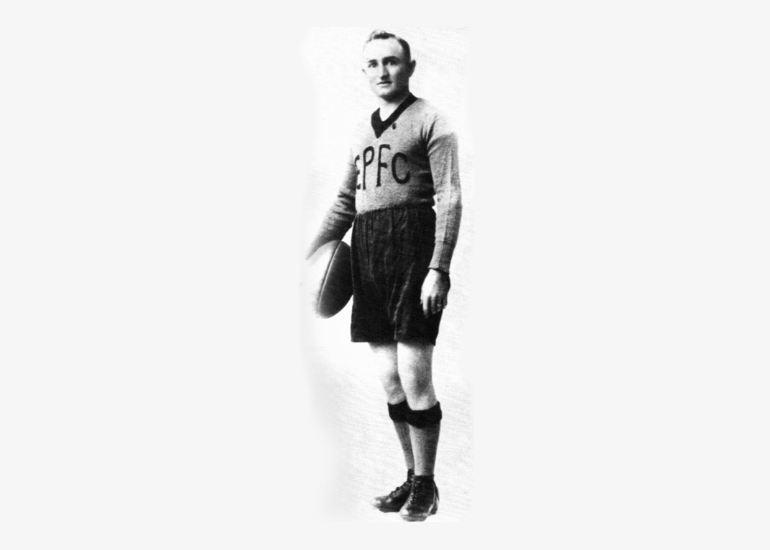

WCG tackled all aspects of football
PLAYER, coach, administrator … there’s not a lot in football that William Charles Gordon Thomas didn’t do … and it all involved the East Perth Football Club.
Known generally as WCG, or Billy, he had the right breeding, having been born into a Fremantle football family when the Port town was the hub of the game in the West. He learnt the sport in Geraldton and the Goldfields before joining the Royals to make his mark in the WAFL.
The son of prominent North Fremantle Football Club administrator Jack Thomas, who was reportedly a captain of one of the early Fremantle football teams around the late 1890s, Thomas jnr went to Geraldton as a six-year-old with his family, where he played football at school and in junior ranks.
In 1922, aged 19, he graduated to the Geraldton Railways Club, captaining the side in 1924 before being transferred as a Post Office telegraphist to Coolgardie, where he played in 1925 and part of 1926 with Kalgoorlie City.
When he was transferred to work at the Perth GPO in 1926, the East Perth officials spirited him away from the eyes of rival clubs, as it was too late in the season to obtain a clearance. He accepted the club’s hospitality and attended training and it was a waiting game until the next season.
But when the 1927 season opened, the Royals had quality rovers in Larry Duffy and Val Sparrow filling the on-ball positions and Thomas had to be patient. However, two games into the season, injuries and illness saw that pair unavailable and the vacancy opened up for Thomas to make his league debut. Legendary captain-coach Phil Matson was ‘quite impressed’ and the lightly-built rover was never dropped again,
Thomas quickly justified that promotion and was in the East Perth team that won its seventh flag under Matson.
Thomas won the Guthrie Gold Medal for the fairest and best player in 1928 and again in ’29, the year he achieved the ultimate honour in WA football with a Sandover Medal.
In the era of single vote-casting by the umpire, Thomas and Subiaco great John Leonard each received five votes, but because the Lions rover had previously won the Medal in 1926, League President A.A. (Alf) Moffat declared that the award should go to the East Perth player – a decision reportedly conveyed to the Post Office telegraphist by telegram!
Thomas was a proud Sandover Medallist.
However, he often played down his Medal win, believing the fact that East Perth was down the ladder in 1929 and a relatively weak side helped him.
A right-footer, Thomas was an expert at the stab pass and was renowned for pin-pointing his kicks. He even used the place kick in a game.
“Young Easts have several champions in the team, but none has shone as brightly and consistently this season as Thomas,” read one report.
Standing just 167cms, or a relatively small 5ft. 6in. in the old language, Thomas weighed in at 66kgs (10st 4lbs), but compensated for a lack of size with brilliant speed and great courage. His daring excursions into the scrimmages were nearly always capped by an accurate right-foot stab kick to an unmarked man. Brains and ability made him a valuable team-mate and a dangerous opponent.
In 1929, further successes awaited him.
Thomas was selected to represent Western Australia against Victoria and South Australia, named as the first rover and media reports indicate that he acquitted ‘himself with honour’. He was the only WA player to appear in every match at the 1920 Carnival in Adelaide, but in his typical modest manner, he only recalled his interstate games for the mistakes he made.
Thomas played through to the 1934 and ’35 seasons, but only when needed in an emergency and then added just one game in 1936, which ultimately was a premiership year.
Son Keith Thomas remembers his last match:
“It was against South Fremantle, at Fremantle Oval. He always went to training, but he was 33 years old and hadn’t been playing. One week they were short, so he filled in for the game and he paid for it; he was pretty sore for a few days.”
Thomas coached the Royals in the 1942 under-age season and went on to serve for many years in administrative posts, as Treasurer from 1932-41 (after Fred Book took on the role of Honorary Secretary and Thomas volunteered while still playing) and President from 1951-55 and he also served as a League delegate for one season.
Team-mate and later league coach Val Sparrow described Thomas as a man of great integrity. “He was always ready to give a helping hand to those who needed it. He was a fine man.”
Peter Spencer
Fact File
Born: January 11, 1956, at Subiaco, WA
Games played: East Perth 185, North Melbourne 24, Subiaco 21, Claremont 2, WA 7.
Guernsey No. 3
Position: Rover
Won Medals at age: 20 and 28
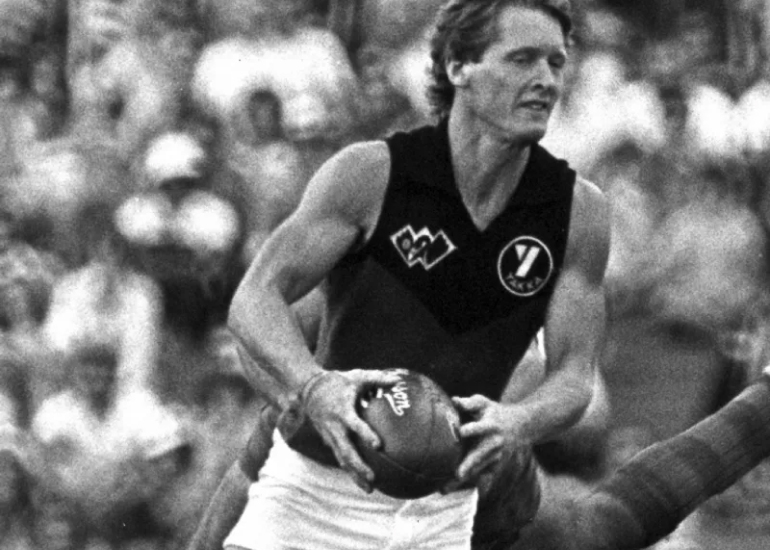

Slice of history for ‘Spanna’
MANY Sandover Medallists have carved a slice of history with their victory … and East Perth’s Peter Spencer has a notch all of his own.
The affable ‘Spanna’ won his two Medals eight years apart, creating the longest gap of any dual Medallist and while triple champion Barry Cable had his third victory nine years after his first, he did have one in between, with gaps of three and four years.
As a warm favourite in 1976, Spencer justified that status, but his victory in 1984 was not only part of a unique triple dead-heat, but was also a reward for a player thwarted by injuries.
After joining East Perth under the father-son regulation in 1974, straight from Aquinas College football, Spencer h ad a career with some remarkable highs and lows, finishing on 185 games for the Royals – the same tally as father Jim.
It seems Spencer was always destined to win a Sandover Medal as he captured the attention of the umpires from the outset.
In just the fifth game of his debut season, Spencer received a fractured jaw from a sickening clash against Swan Districts. He returned to add eight games before the season finished and still polled 14 votes in the Sandover, finishing equal fourth on 14 behind winner Graham Melrose on 20.
The 1975 season saw the Royals dominate the Medal leader’s board as dashing half-forward Alan Quartermaine won with 16 votes, with Spencer and a third Royal in Ross Glendinning sharing second place (with Stan Nowotny) on 14.
So the 1976 season opened – and closed – with Spencer a Medal favourite, especially after scooping many media rewards, including The Weekend News and The Sunday Times footballer-of-the-year awards for a second successive season; the Tatt’s Gold Cup and the Radio 6IX best player honours.
“I remember going to the Channel 7 studios for the vote count,” recalls Spencer. “At the end of the first round, I was pretty well sitting where I thought I’d be, just off the pace with five votes. But it was the second round that did it for me.
“During the season Polly Farmer (coach) had me doing some additional running, as he felt I needed an extra edge against the blokes I was playing on in the centre. It obviously helped, because I got nine votes and then finished with seven in the final round of matches.”
It was a low-key celebration after the Sandover victory, with team-mate Glendinning dropping Spencer off at his Manning home, where a few people had joined his parents, Jim and Betty.
“We were playing South Fremantle in the second semi-final that weekend and I was focused on the finals,” says Spencer. “I started in the centre on Stan Magro and kicked two goals before copping a knock on the bum. We won, but it took a fair bit to recover, even though I did play OK in the grand final. But we were down to 17 men by the final siren and Perth were too good.”
The low-key approach to the 1976 Medal count was in stark contrast to Spencer’s 1984 win, with the function held in the Perth Entertainment Centre, then owned by Channel 7.
After an enormous build-up to the first Medal count open to the public, the event turned into a shambles, with a disappointing crowd, both in numbers and behaviour.
“What was disappointing was the crowd booing players,” says Spencer. “It’s a prestigious award and it didn’t matter who was getting the three votes, they were booing all the time. The cheering and jeering was totally out of place for that night.”
Despite the crowd reaction, the count itself was an amazing one as, for the first time, a three-way tie resulted … and Spencer actually went home without a Medal.
Donor Robin Sandover always went prepared for a dead-heat, with a spare Medal in his pocket. However, when Spencer tied with Claremont pair Michael Mitchell and Steve Malaxos on 17 votes, Sandover was caught out and asked the Royal star would he mind waiting a few days, especially considering he already had a Medal at home.
“I had no qualms about not receiving it on the night,” says Spencer. “I picked it up at the League later.”
While Spencer agrees that 1976 was his best season and the first Medal remains his No. 1 highlight, he also rates his 1984 victory highly because it came after a sequence of injuries that would have stopped many a player.
A broken jaw, a fractured cheekbone, a number of concussions, a devastating pubic synthesis operation and right knee problems cost him more than a season in total games missed, including two matches out with concussion in 1984.
Those injuries changed Spencer’s style of play, slowing him down and forcing greater use of handball to compensate, especially after the 1979 season when he also had his right leg in a brace after an operation for roughening behind the knee cap.
“I only had the brace on for 10 days, but the muscles wasted so much I never really regained power in that leg and subsequently lost pace,” says Spencer. “That forced me to use handball as a weapon.”
Spencer’s two seasons with Victorian power-house North Melbourne (1981-82) saw him finish a promising eighth in the club’s fairest and best first-up, but then injuries, coupled with the arrival of champion Claremont pair Jim and Phil Krakouer, limited his opportunities.
A further sequence of disappointing factors affected the culmination of Spencer’s career.
A contract dispute at East Perth saw a move to Subiaco, where he played in the 1985 grand final side (losing to East Fremantle by five points), but he then fell out with coach Haydn Bunton over his playing style.
Spencer moved to Claremont, but received concussion in his second game and after missing the rest of that season, he returned to East Perth in 1987.
“After missing most of 1986, the neurosurgeon recommended that I retire. But I wanted to finish on my terms and also back at East Perth and Trish and the family supported me.”
Spencer was runner-up in East Perth’s 1987 fairest and best award; seemingly an apt justification of his decision to play on. In fact, the courageous on-baller finished first or second in the club’s FD Book Medal in eight of his 11 seasons at East Perth.
“I was very satisfied with the comebacks and after that up-and-down journey to finish on the same number of games as dad was incredible,” he says. “He had helped me all the way through my footy from under-10s and to finish together was unbelievable.”
The 1978 season at East Perth was among the Spencer disappointments as he missed the grand final with injury.
“I just wasn’t quite ready,” he says. “I was Barry Cable’s runner on the day, but really, I felt as much a part of the team as the bloke serving hot dogs on the hill. The premiership belongs to the players and the coach.”
With father Jim a former Royals captain, there was never any doubt about Spencer joining East Perth.
Spencer, one of three brothers with Terry and David, played his junior football in Perth’s district at Manning – which produced Wiley for Perth and Peake for East Fremantle at the same time, with renowned juniors mentor Jack Ivankovich as coach.
After an outstanding career with Aquinas College, in the Public Schools Alcock Cup competition, Spencer went straight into the league side in 1974.
Brady Anderson
Fact File
Born: June 12, 1975, at Mt Lawley, WA
Games played: East Perth 33, Kangaroos 27, Swan Districts 31, WA 1
Guernsey No.: 3
Position: Wing, half-forward
Won medal at age: 22
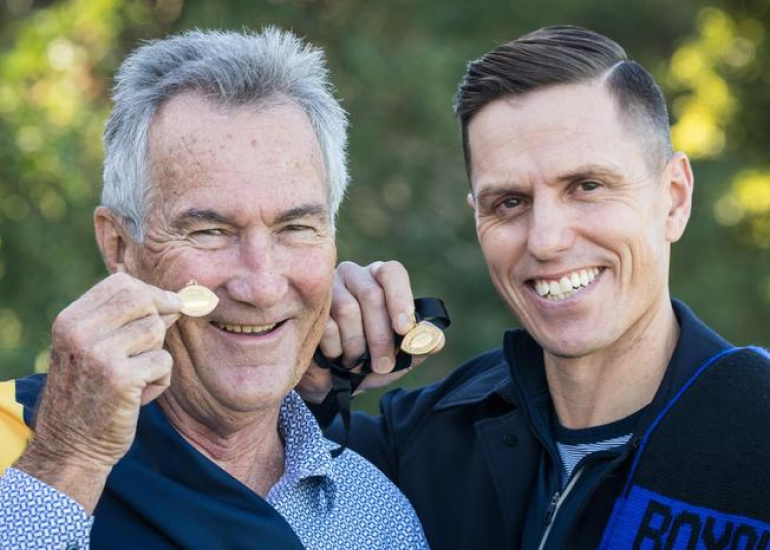

Proving a point paid off
WHEN a footballer wins a Sandover Medal, the question is asked as to why he played so well in that particular season to attract the attention of the umpires.
In the case of Brady Anderson in 1997, his superb form can be traced back to what happened at Geelong the previous year – or rather, what didn’t happen. After not getting a senior game and being de-listed, Anderson was determined to show he did have something to offer.
Anderson was hoping for another chance with Geelong, but after a shoulder reconstruction, the best they could offer was a spot on the Rookie List. Anderson decided that coming back to East Perth was his best option and he worked hard to get in good shape.
“I felt like I had been kicked in the guts by being de-listed, that’s what made me a better player the next season,” says Anderson. “After my shoulder reconstruction and the surgeon’s news that it wasn’t too great, Geelong said they would cut me.
Leading up to the 1997 Sandover Medal count, rumours were circulating about a leak in the voting, but Anderson was the last to know about the speculation. In fact, he was not even invited to the count originally, with a restricted number from each club. But he was a late addition to the Royals table – and even then he didn’t react to the situation.
“When I got to the count, I was in the toilet and someone said I’d already won it and I just had a laugh. But as it turned out there had been a leak and some people did know, which resulted in a bit of an inquiry.”
The rumours of victory put plenty of attention on Anderson early in the count, especially when he didn’t poll a vote in the first six rounds.
“It was a bit embarrassing,” he recalls. “I had a few beers to calm my nerves and then it just went so fast. It was a great night.”
Even as the count progressed, Anderson never believed he could win. But when he received five votes in the final round and his name was announced, the victory finally sunk in.
“In the last round I needed five votes to win,” he said. “Everyone was so pumped, my mum, dad, my friends, my Nan, they all came onto the stage and it was such a special night. My best memory was seeing Nan standing on a chair in the Casino later that night leading the guys in singing the East Perth song.”
Anderson’s win was also significant for another reason – 1997 was the year the WA Football Commission awarded Medals retrospectively to players beaten on a countback in bygone years. He still cherishes a photograph taken on the night of him standing between two other Royals – Frank Allen, who lost the 1950 Medal and the legendary Graham Farmer, who received a third Medal for his 1957 loss.
As a youngster, Anderson honed his football talents firstly with the Belmont juniors and then at Mazenod College, a strong Hills football school. Joining East Perth through zoning, Anderson quickly went through from colts to reserves and seniors.
“I started playing for the Belmont footy club at the age of four and when I was 13, I went to Mazenod, where I played until I was 17,” he says. “I joined East Perth’s colts in ’91 and stayed until the end of ’95, when I was drafted by Geelong.”
Anderson’s football dream took shape when he was selected at No. 68, but it was to be a tough road ahead.
“All I wanted to do was play AFL footy, so it didn’t really matter who picked me up,” he said. “It was good at Geelong, with Gary Ablett still playing and stars like Billy Brownless and Paul Couch. I was an emergency four times and one of those was after I’d had 42 possessions in the twos. After that, I thought I might not get a crack at it and once I did my shoulder that was it.”
Anderson was determined to get back into the AFL and his Medal-winning effort earned that second chance – this time with North Melbourne, the club he barracked for as a kid.
“I had talked to a few clubs, but didn’t get picked up in the draft, but got the call-up in the pre-season draft from North Melbourne,” says Anderson.
“I was pumped as they were the best team of the 1990s. It was unbelievable with Wayne Carey, Anthony Stevens, Glenn Archer and so many more. It was great to be there, but because they were such an amazing side it was hard to break into.”
In his first year at the Kangaroos (1998) Anderson played in the Ansett Cup (pre-season) premiership side and then made his AFL debut. However, despite a solid season, he missed a spot in the team for the finals and a subsequent grand final loss to Adelaide.
Even though Anderson’s opportunities were restricted over the next two seasons, he was grateful to play in such a good side – alongside Carey; who he rates as the best player he’s seen – and under coach Denis Pagan; whom he learnt so much from.
“I feel lucky that I got the opportunity to play AFL footy,” he says. “There are so many guys in football a lot better than me who never got the chance.”
After leaving North in 2000, Anderson and his future wife Annette moved to London for two years, where they started up a personal training business – and got married.
The break helped Anderson rekindle his desire to play football and on returning to WA, he was attracted to Swan Districts, who were looking to rise from the bottom of the ladder.
Anderson had a great 2003 season, averaging 25 possessions a game and formed a potent partnership with Sandover Medallist Shane Beros. However, the 2004 season saw Anderson hampered by injuries and with work commitments increasing, he decided it was time to retire for good.
“I really enjoyed my footy at Swans and we just missed the finals after winning only one game the year before,” he says. “Then in 2004 I got sciatica and had bad hamstring problems. I found it hard sitting on the sidelines.”
Most footballers have certain people who influence their careers and for Anderson it was his parents, his colts coach and most of all, Wayne Stevens.
“My parents, Pete and Lin, had a big influence,” he says. “Ross Nash was a coach at the East Perth colts and he stayed as my mentor. Wayne Stevens rehabbed my shoulder the year I won the Sandover and he got me ready to play AFL the next year; he’s been my best mate for years as well.”
David Bain
Fact File
Born: May 2, 1966, at Albany, WA
Games played: East Perth 72, Brisbane 86, Fitzroy 12; WA 2
Guernsey No. 3
Position: Rover
Won Medal at age: 22
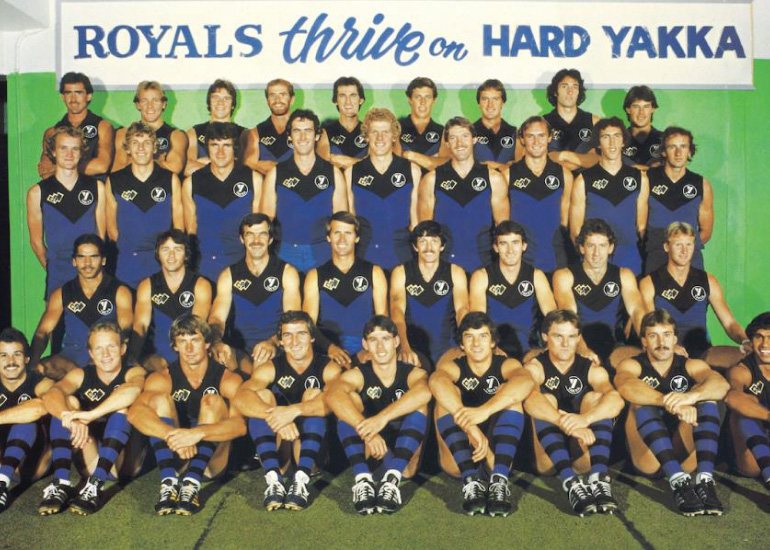

Magical season for mighty midget
DAVID Bain’s fourth and final year in the WA Football League reads like a football fairy-tale … a nail-biting Sandover Medal win; an East Perth Fairest and Best and an AFL contract.
What’s even more striking about his stellar 1988 year, however, was the rather unorthodox pre-season.
Born in Albany, in southern Western Australia and in a strong Claremont zone, Bain played junior football with Maylands when his family moved to the city – and that was East Perth territory, the WAFL club he supported.
After graduating through East Perth’s under-age and colts ranks, the lightly-framed small man made his league debut in 1985, but felt like a change at the end of the 1987 season, so he played the summer in the tough Darwin competition and while he obviously missed East Perth’s pre-season, he returned fitter and stronger.
That led to a solid year playing as a rover and the tenacious on-baller arrived at the Burswood Resort as one of the favourites for the 1988 Medal count.
Bain recounts his special night with great humility and though he celebrated in fine style, courtesy of East Perth’s seventh position on the ladder, the memories remain vivid.
“It was an amazing night,” recalls Bain.
“I was a pretty warm favourite, not that favourites had done all that well in recent years and a few team-mates such as Butch Baroni, George Giannakis and Gavin Hawkins had good seasons.
“It was a thrilling count, beating Craig Edwards by one vote. He went on to win the next season, so when we sit down now at Sandover Medal nights, we talk about the two counts.
“East Perth’s season was over so we had a good celebration at the Burswood. We got home about 6am and the television crews were there at 7! Some team-mates were still there and we were all a little incoherent. One of the guys played the interview tapes at my 40th birthday recently and that was rather funny.”
While that night was memorable and clearly sticks in Bain’s mind, it did help to erase one of his more painful football memories.
Having established himself in the Royals team in his first two seasons, he was chosen in the initial West Coast Eagles squad at the end of 1986 to play in the expanded Victorian Football League (later the AFL). But as WA’s entry into national football excited everyone, Bain was the last player cut before the final team was announced.
Despite the disappointment, Bain put in a solid 1987 season, after which he decided to tackle Darwin.
“t was an amazing experience playing with all the indigenous guys; they are so quick and really dominate and the white guys playing there were called cream puffs! It certainly was an initiation into a different brand of footy,” he recalls.
This wasn’t the last time Bain would face a change of script as he played top-flight football in three States over 10 years, compiling 172 senior games.
Bain’s 1988 season influenced the Brisbane Bears, also new to the national league, to draft him as they collected players from around the country.
The move to Queensland was a challenge, not only leaving a State steeped in Australian Rules history, but moving to a new culture, complete with a glitzy corporate world in a State void of football tradition.
“I was thrilled to move to Brisbane after missing the Eagles,” says Bain. “I didn’t care where I played, I just wanted to be part of the new league.”
Despite the big cultural shift, Bain was flanked by close friends, including his wife-to-be Janine and a host of WA footballers.
“Janine got into teaching and we ended up staying for quite a few years,” says Bain. “We really loved Queensland and it was good having blokes like Alex Ishchenko, John Gastev, Mark Zanotti and Brad Hardie around. I was living with Alex for a while and being a former East Perth player and Maylands junior we knocked around a fair bit.”
Amidst all the glitz and glamour of the Gold Coast, Bain continued his good form, winning Brisbane’s Fairest and Best in his second season and polling well in the Brownlow Medal, finishing fourth, three votes behind winner Tony Liberatore.
In the era when AFL players were on the cusp of receiving handsome salaries, Bain balanced football with an off-field career, working in marketing after obtaining a degree at Edith Cowan University, in Perth.
“I had a day job, as the footy money wasn’t enough to justify going full-time and most players were working at other things,” he says. “The club encouraged this, which was good as there was certainly a holiday atmosphere on the Gold Coast. It was fairly easy to get swept away and plenty of guys didn’t let footy stop a good time.”
After 86 games and five seasons with the Bears, Bain found himself on the road to Fitzroy.
“I was drafted to Fitzroy in 1994 as part of a pre-season deal involving a few players,” he says. “I was starting to play a few reserves games and I guess Brisbane were happy to get a trade for me. Fitzroy was certainly a change! They were struggling financially, but it was great to play in Melbourne and with a club that had a long VFL history and a real ‘playing-for-the-jumper mentality.’
“I had a mixed season, 12 senior games and 10 in the twos, but surprisingly I won the Gardiner Medal for the fairest and best player in the reserves competition.”
Having etched his name into the Fitzroy records books, Bain hung up his AFL boots and returned to Queensland to wind down his playing days in the State league.
“It was a lifestyle decision to return to Queensland, with football not the main priority, although it was great playing for Southport, in the QAFL,” says Bain.
Bain is now settled in Perth, working as a licensed real estate conveyancer in his own company, Kings Park Settlements, while wife Janine and young son Thomas, rising four, enjoy the easy-paced life of Perth.
Bain occasionally wonders where football might have taken him if the family had stayed in Albany.
“It was great when we came up, especially living in Maylands, because my grandparents barracked for East Perth,” he says. “I went through to under 18s and then East Perth colts, when we finished runners-up under coach Greg Henderson.”
Bain has certainly completed the full football circle – from under-10s with Maylands; into WAFL ranks with East Perth; to a Sandover Medal in the local league; then the national competition with two clubs and, finally, premierships in the Queensland State league.
“I have some great memories,” says Bain. “I have strong ties with East Perth, having barracked for them all my life and developing through their ranks was special. However, I do have fond memories from the other clubs. Southport and the four premierships were particularly memorable; plus I enjoyed State-of-Origin football and just being a part of the newly-formed national league was tremendous.
“I played one State game at the WACA Ground and another at the MCG and running around with basically an Eagles premiership side was a real buzz.”
Bain’s selection in the 1990 Australian team under legendary coach David Parkin to play the hybrid Gaelic game against Ireland in Australia was another reward for his great season, with matches in Perth and Canberra.
While Bain obviously treasures all his football achievements, there is no doubting where the Sandover Medal ranks.
“The Sandover is right at the top of the tree,” declares Bain.
“It’s something as a kid you know about, but don’t think you’ll ever get close to it.”
William (Digger) Thomas
Fact File
Born: June 3, 1890, at Broken Hill, NSW
Died: October 6, 1953, at Perth
Games played: Subiaco 32, East Fremantle 17, East Perth 177, WA 6
Guernsey No. 1
Position: Centre
Age when won Medal: 33
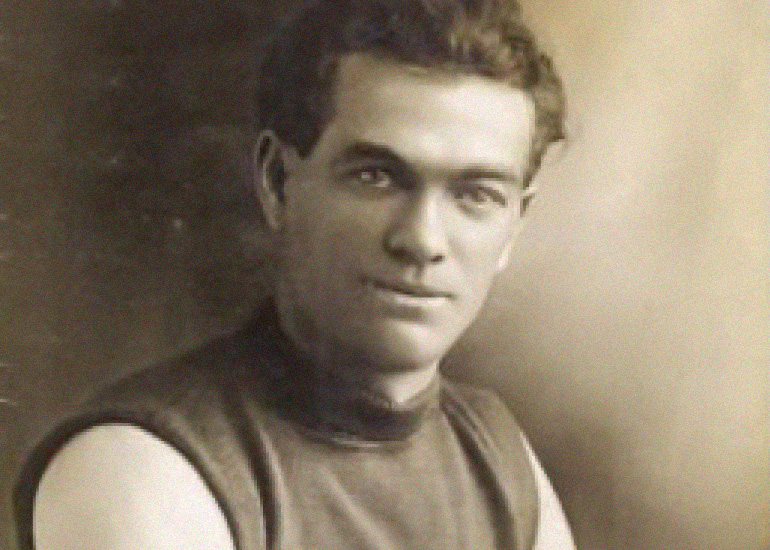

Name synonymous with the game
THE name Thomas features twice in the first nine years of Sandover Medal history – but while the two winners were East Perth premiership team-mates, they were not related.
However, the football pedigree of William Alfred Benjamin Thomas – better known as Digger – is pretty impressive in its own right.
He had a Goldfields upbringing to mold his football foundation; he had a contemporary Medallist in George (Staunch) Owens as a cousin and he sired a 207-game league footballer himself – yet another East Perth star in Ritchie Thomas carrying on the name.
Thomas snr won the Medal in its third year, 1923, with Owens following in 1925 and then William Charles Gordon (Billy) Thomas claiming his Sandover in 1929.
That third Sandover Medal, in itself, has a slice of history attached to it. Historians have failed to find any reference as who he beat or how many votes he received.
The old East Perth Power House played an important role in the history of the East Perth Football Club’s early years, with inaugural president Tom Guthrie helping organise employment for many players.
So it was somewhat fitting in a way that one of the early employees in Thomas passed away there when working as the caretaker in his latter years.
Thomas lived in the caretaker’s cottage and had gone to the Power House at 9 o’clock one evening to do his regular checks and was found collapsed from a heart attack when the early-morning workers arrived, including son Ritchie.
Even in his early working life Thomas maintained the East Perth link.
Before joining the Power House as a fireman, he worked at the old Premier Theatre, in Bulwer Street, just near Perth Oval, which was owned by East Perth official Cyril Norton for many years.
Thomas was something of a football wunderlust even though he is one of only three players to feature in that historic run of five consecutive premierships, from 1919 to 1923. Cousin Owens was another, along with Larry Duffy.
Thomas had already notched a premiership with Subiaco, in 1913, before joining East Perth in 1915 – but even then he didn’t settle at Perth Oval, having a one-year stint with East Fremantle (1917). He returned to be a part of that wonderful premiership era under legendary coach Phil Matson – who had been a team-mate in that Subiaco premiership line-up and then a rival centreman before linking up again at East Perth.
After his run of five premierships, Thomas ventured to Sydney in 1924 and coached the Paddington Aussie Rules team and then journeyed to Melbourne to play with Richmond – but when he couldn’t get a clearance (as was common in those years) he rejoined East Perth.
He was back in time to add the 1927 premiership to his glowing record, although in his absence Matson’s Royals had also claimed the 1926 flag.
Thomas rates renowned Victorian centreman Ivor Warne-Smith as the best he played against – at the 1924 Sydney Carnival. On the home front, Thomas liked the style of latter-day midfielders in West Perth’s champion wingman Stan (Pops) Heal and Clive Lewington, the South Fremantle fellow-Medallist and a centreman of class.
Thomas also had many classic battles in the centre with William (Nipper) Truscott, the legendary Goldfields player who joined East Fremantle in the 1920s. While Thomas was judged to have won the duel on some occasions and been shaded on others, Truscott had the superior disposal skills, but the East Perth star possessed greater pace and was stronger in the air.
Thomas married Myrtle and had two children, both of whom are deceased. Son Ritchie’s widow Doreen lives in a retirement village north of Perth, while daughter Muriel’s surviving husband, Roy Avins, lives south of Perth, near Mandurah. Thomas’ second wife Maude had one child by a previous marriage.
Ritchie Thomas inherited his father’s dedication towards physical fitness and after his 1946 retirement following his long career with the Royals, he often featured in the club’s pre-season preparation. Together with wife Doreen, he ran the popular Lancelin Hotel, at the coastal resort north of Perth, where the many sandhills provided the menu for a hearty physical fitness challenge for the players.
A fitness guru with an Army background, Ritchie played four games with Essendon during World War II – something that his father had been prevented from doing.
Some 30 years after his Sandover Medal victory, the Mirror newspaper had this interview with Digger Thomas on June 6, 1953:
Down at the East Perth Power House, the bright, chirpy boiler cleaner, toils.
W. (Digger) Thomas, one of the greatest centremen to pull on a jersey, is a hale and hearty 63 and treasures among his football souvenirs the 1923 Sandover Medal, the third-ever presented and the first won by a centreman. He was 34 when he won it!
He started his football with Warriors, at Kalgoorlie, in 1908 at the centre and specialised in that position almost exclusively until he put away his togs about 1928. In later years, he was at half-back and half-forward.
Digger came to Perth in 1911 and started with Subiaco and was in their premiership team of 1913.
Few people know that Digger then played a season with Old Easts, being their centreman in 1917, having crossed from East Perth and transferred back to the Royals in 1918.
In 1915 he started with the club with which history links him most – East Perth and participated in the famous five premierships of 1919-23.
Digger played in the Carnivals of 1914, ’21 and ’24 and played at the pivot in all of them, sharing that position and the wing with Nipper Truscott at Sydney in 1914.
In the 1921 Carnival at Subiaco he was in such sparkling form that Victoria tried six men on him at various stages. They all took a shellacking.
Digger says that some of the hardest players he found to beat in club football were Truscott, Subiaco’s Jack (Snowy) Hamilton and South’s Norman (Snowy) McIntosh.
He played against his subsequent coach and close friend Phil Matson at the centre when Matson originally played for Subiaco and says of him: “Now, there was a footballer!”
He rates Mick Cronin as the best player he has seen of the moderns and places him among the best of all time.
The game he enjoyed the most? The 1921 clash with Victoria.
“I wouldn’t have minded getting killed in that”, he said.
The main attribute of a centreman? Brains.
Frank Allen
Fact File
Born: December 5, 1926, at East Perth
Games played: East Perth 190, WA 11
Guernsey No.: 2
Position: Wing
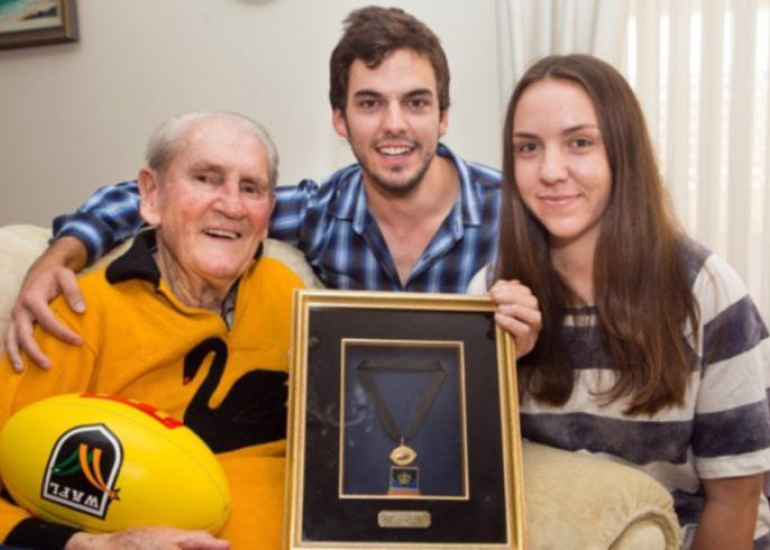

Royals Insider (Newsletter)

